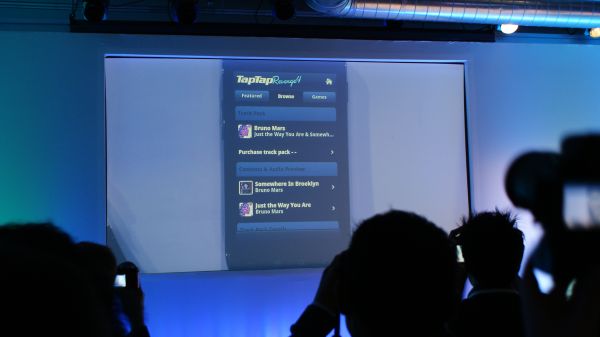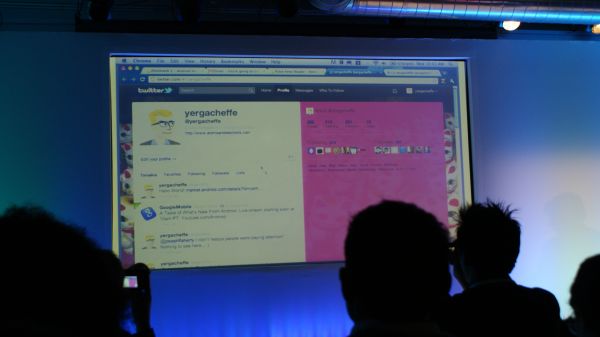Google's Android Event Analysis
by Mithun Chandrasekhar on February 2, 2011 4:26 PM ESTToday's Android event had just one real announcement; the Android Marketplace webstore (which is Live at market.android.com). The rest of it was just a Honeycomb/Motorola Xoom show-and-tell, with various Google-partners coming on stage and showing their apps running on the Honeycomb platform. As such, this article covers the details of the Android Marketplace webstore and other updates first, followed by impressions gathered during the Honeycomb/Xoom hands-on.
So yes, the main announcement today is the fact that Android Marketplace is now going places! Google was talking about cloud services, how it is playing an increasingly important role in the Android eco-system and how smartphones, tablets and other mobile devices would benefit from cloud service integration. Nothing new or particularly exciting here, except that Andy Rubin did drop hints of such integration coming over to other Google platforms (such as Google TV) some time in the future.
An app purchase on the Android Marketplace web store gets pushed to the Nexus S
Back to the Android Marketplace; it is now possible for users to browse the Android Marketplace from the comfort and convenience of their desktop browsers, make app purchases in the browser and have the app pushed to their Android mobile device. It is as simple as that in practice as it is in idea. If the application you are planning on purchasing is free, you can actually get through with the process in a single click. Purchasing a paid app would require the additional step of entering your payment information. During the demo, an app purchase made in the browser was pushed to the Nexus S phone within a couple of seconds. Apart from purchases, users can also share apps from the webstore. Again, nothing revolutionary, but effective in it's simplicity and execution.
Disney Mobile demonstrating in-app purchases in Tap Tap Revenge 4
It's possible to share applications via the Android Marketplace web store (Twitter example shown here)
But the Android Marketplace updates weren't just end-user oriented. Google realizes the importance of developer support and keeping developers happy will certainly help Android maintain its momentum forward. To this effect, with the introduction of the web store, Google has given the developers more control over how they can promote and monetize their applications. Developers can make use of high-resolution banners and youtube video links on their store front. Plus, the web store will show other apps the same developer has to offer, thereby making an attempt to reduce the bounce rate. Updates have also been made to the payment system with more leeway given to the developer on buyer currency support. Unlike the previous set-by-Google rates, developers can explicitly choose what rate they may want to charge foreign currencies, although they can fall back to the default Google rates if they choose to do so. This feature is going to roll-out gradually, with initial support for the US dollar only. Another big update on the monetization front is the support for in-app purchases. The developers can now sell 'packs', 'updates', 'maps' and other add-ons to their application, without the user having to leave the app. This will certainly boost app development for Android and provide developers the incentive to continue supporting and upgrading their existing applications for longer periods. Disney Mobile was at the event to show off some of the applications they have ported over for to Android and their 'Tap Tap Revenge' application seemed to make good use of the in-app purchase system, wherein the user can purchase additional soundtracks from within the game.
Nothing particularly exciting here, but all in all, worthy updates to the Android eco-system.




















22 Comments
View All Comments
rpmurray - Thursday, February 3, 2011 - link
The Xoom (what a dumb name) looks like just a bigger Android phone. That bezel is huge. The OS is just a glorified phone OS, not a real OS. You can't run real applications like Microsoft Office or Adobe Photoshop on it. It doesn't have a stylus. It's too big. It's too small. It doesn't have a physical keyboard. It costs too much for what it does. I can buy a netbook for less that does more. This is just a toy.Are there any other stupid or asinine comments I forgot to recycle from when the iPad came out, but which the fandroids won't apply to Android tablets because they're "open"?
psypher - Thursday, February 3, 2011 - link
Speaking as an iPad owner:The iPad runs some great applications, although Office and Photoshop are better than their iOS counterparts (good thing I have computers for those...).
The touchscreen keyboard on the iPad sucks. If it had Swype like my Droid X, that would be a different story, but it doesn't, so I hate it. I have the BT keyboard for the thing, but carrying it around kind of defeats the purpose in my opinion.
Size: personal opinion. I don't see myself getting a 7" tablet ever. Roughly 10" feels right to me. Others may prefer smaller, larger, whatever.
Cost: If you can't afford it, don't buy it. Same as anything else in this world.
All that said, my 64 gb 3g iPad is going on ebay this week so i can get a Xoom for my wife (unless anyone here wants it for the right price). Do I like "open"? Yes. Am I a Phandroid? No, I just like the product that fits my use scenarios the best and the Xoom seems to do that more so than the iPad this round.